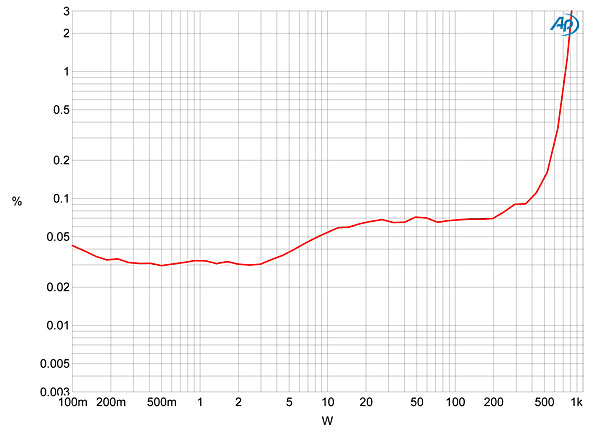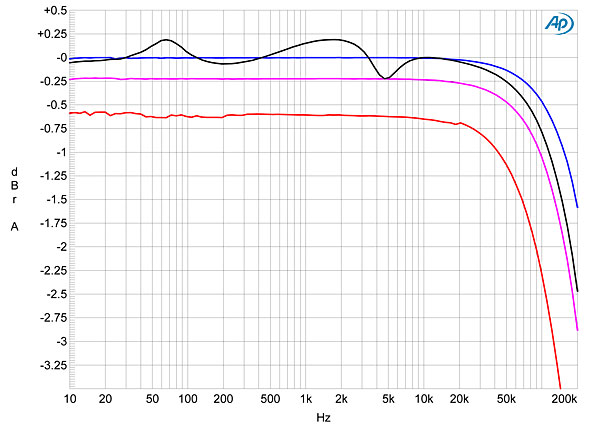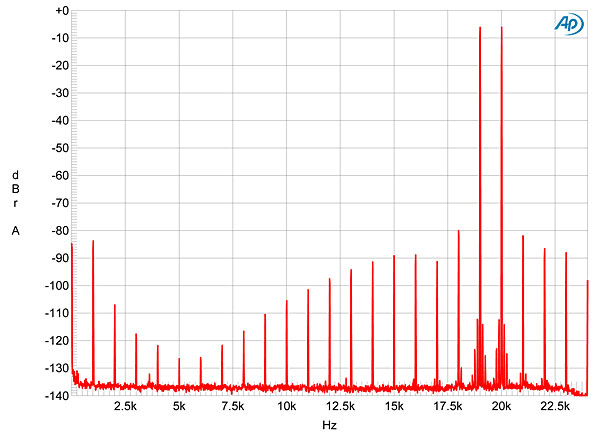Why not?Degeneration is not equivalent to feedback.
Why?This is flamboyant nonsense.
Best regards!
On topic
I can argue that GNFB has set progress back in music reproduction in the sense that it has focussed too much attention on poorly correlated measurements, very often to the detriment of the music. Taken to extremes, the pursuit of low THD, which is enabled by high NFB, leads to denial of the musical performance and, worse, questioning the human auditory system. Focus is stolen from attention to important circuit behaviour.
There is, generally, weak correlation between the common measures of GNFB, such as THD and output R, and musical performance reproduction. There are examples of zero GNFB amps that convey music much better than a high GNFB amp.
I can argue that GNFB has set progress back in music reproduction in the sense that it has focussed too much attention on poorly correlated measurements, very often to the detriment of the music. Taken to extremes, the pursuit of low THD, which is enabled by high NFB, leads to denial of the musical performance and, worse, questioning the human auditory system. Focus is stolen from attention to important circuit behaviour.
There is, generally, weak correlation between the common measures of GNFB, such as THD and output R, and musical performance reproduction. There are examples of zero GNFB amps that convey music much better than a high GNFB amp.
Last edited:
Which is why some people are more interested in IMD. Have you any IMD measurements of your amps Hugh?
I can argue that GNFB has set progress back in music reproduction in the sense that it has focussed too much attention on poorly correlated measurements
I fail to see a correlation there, just something to stir the pot?
According to what metrics? Sighted reviews need not apply.There are examples of zero GNFB amps that convey music much better than a high GNFB amp
I hope I am stirring you to question your assumptions. I do believe what I wrote. I always listen to circuits to judge how well they convey music. That’s how I measure what positive and negative effects arise from GNFB in those circuits. Correctly attributing those effects to electrical phenomena requires a little anarchy.I fail to see a correlation there, just something to stir the pot?
According to what metrics? Sighted reviews need not apply.
So anecodote? That's fine I can ignore that with all the other ones people post on here as if they were facts.
Go for it, no one's stopping you, or are you afraid of giving people "ideas"?Correctly attributing those effects to electrical phenomena requires a little anarchy.
You could appropriately define distortion in terms of molecular stress, strain and deformation, but you can`t methodically establish a quantitative estimation, nor can you define quality.
What anecdote?So anecodote? That's fine I can ignore that with all the other ones people post on here as if they were facts.
There are examples of zero GNFB amps that convey music much better than a high GNFB amp.
That anecdote.
Let's take the MX-R Twenty:[...]You can root around in the Stereophile review archives - plenty of examples.
Ayre MX-R monoblock power amplifier Measurements | Stereophile.com
[...]
The problem with the ZGFB amps is that they never are 0.1% at full power and with a real load. They more often than not 5-10x this figure on steady state sine wave tests at mid to high power.[...]

That is into 2 Ohms...yes, not a real load, but a difficult one.
[...]Then look at the Frequency response. Getting flat response out of an amp is not actually easy. Typically there is some output variation because Zo is finite - but some of the ZGNFB are all over the place in this regard.

The black one is into a real load. +/-0.26 dB is not what I would call all over the place, if assessed with Music and real world rooms, real world humans, and real world loudspeakers.
If it is assessed purely on an academic basis, then yes, 0.26 dB are a huge deviation.
[...]The other one is IMD - a food example of which was posted earlier on this thread.

Not too shabby, all components under -80dB. At 200 W into 4 Ohms.
Seems a competently designed amplifier. With no global or otherwise deliberately added NFB loops, no EC and such things.
Did anyone here already perform those listening tests?
Are you closer to -40 or -60dB detection level with music?
For $16500 a pair I'd rather have 30dB better performance. That's a LOT of IM products with only 2 tones. I'd let a $1000 amp get by at that level, but fail to see what I am paying so much for.
You will find some listening tests on here organised by PMA that will let you decide if people can detect well below -60dB with music.
You will find some listening tests on here organised by PMA that will let you decide if people can detect well below -60dB with music.
And what are statements that zero global feedback amps are audibly worse because such amps have too high distortion/too high frequency deviation?That anecdote.
DBT backed truth?
.. and the fallacious argumentation continues. Throwing the baby out with the bathwater.But as this tthread reveals, it is not. NFB cannot be applied in infinite amount, so claims that feedback amplifier output is a dead short for speaker back EMF do not hold water.
You clearly belong to what I described. Only ideological black/white thinking.
There are several issues with these statements as well.But why going into the trouble, I wonder. As quite reasonably stated in several posts of this thread, and not disputed by NFB proponents, low distortion and low output impedance can be achieved w/o global NFB. So the point that NFB must be used no matter what is as extreme as the point that NFB should never be used under any circumstances.
First, there are people that are technically interested, that want to understand the circuits, different techniques employed. People, that want to push what is possible even if there's no obvious practical benefit. Limits regarding weight, size, cost, simplicity, linearity, and so on.
Is there some audible benefit to adding another "0" to already vanishing low distortion numbers? No, but it's still an achievement. Technical superiority. A challenge, that some enjoy to tackle.
This is also what drives technological progress.
Sadly, there are also the ideologically driven simpletons that demonize things like global negative feedback. To them, the hobby seems to be congratulating each other on the next more expensive purchase which obviously is an upgrade, duh (even if the amps are so nonlinear that they cause audible effects). Confirmation bias echo chambers.
Secondly, it's again not as simple as "low distortion can be achieved without global NFB". As others have pointed out, for powerful amps (and not mW headphone amps) the distortion actually isn't always that low, and the output impedance still can be high enough to cause an EQ effect.
And some people prefer having a fixed high output impedance that causes an EQ effect, or distortion so high that it audibly colors the sound. Which is totally fine! But that is a matter of personal taste (or lack thereof), not of technical facts.
And I think this is where (a part of) audiophilia has gone completely wrong. Because these people failed to correlate technical facts with subjective, biased experiences, they raise their experiences onto a level that allows them to - seemingly objectively, but this is just an illusion - discriminate between tastes .. and look down on others with "lesser" tastes.
Technical facts are irrelevant for them. They're merely ideological tools.
One would think that this is absurd and could not be true, but the industry has actually adjusted to this and makes good money off of them.
And what are statements that zero global feedback amps are audibly worse because such amps have too high distortion/too high frequency deviation?
I haven't claimed that.
@Bill
Only one example is needed to show that using GNFB is not a universal fix. You like Stereophile, I'm sure you can find an example. How about the Audio Note Ongaku vs any number of budget GNFB amps? And this brings us back to class D. I have my own trial experience from amps I have built.
The music is what matters. If the application of GNFB unexpectedly tarnishes the music you should question your technical assumptions. Otherwise you stop learning.
Only one example is needed to show that using GNFB is not a universal fix. You like Stereophile, I'm sure you can find an example. How about the Audio Note Ongaku vs any number of budget GNFB amps? And this brings us back to class D. I have my own trial experience from amps I have built.
The music is what matters. If the application of GNFB unexpectedly tarnishes the music you should question your technical assumptions. Otherwise you stop learning.
Who said it was?@Bill
Only one example is needed to show that using GNFB is not a universal fix.
the ongaku sums up why high end audio stopped being about high fidelity decades ago and became man cave jewelry.How about the Audio Note Ongaku vs any number of budget GNFB amps?
Or your ears.... If the application of GNFB unexpectedly tarnishes the music you should question your technical assumptions. Otherwise you stop learning.
Let's take the MX-R Twenty:
Ayre MX-R monoblock power amplifier Measurements | Stereophile.com
That is into 2 Ohms...yes, not a real load, but a difficult one.
The black one is into a real load. +/-0.26 dB is not what I would call all over the place, if assessed with Music and real world rooms, real world humans, and real world loudspeakers.
If it is assessed purely on an academic basis, then yes, 0.26 dB are a huge deviation.
Not too shabby, all components under -80dB. At 200 W into 4 Ohms.
Seems a competently designed amplifier. With no global or otherwise deliberately added NFB loops, no EC and such things.
Did anyone here already perform those listening tests?
Are you closer to -40 or -60dB detection level with music?
I’d posit that in absolute terms those performance figures are shockingly bad given the SOTA.
This is a $16k amplifier.
All this anti feedback nonsense was given wings in an article written by Martin Colums in c. 1996 in Stereophile (‘A Future Without Feedback’) which regrettably presented a lot of false information. It’s been regurgitated ad infinitum for the last 25 yrs.
- Home
- Amplifiers
- Solid State
- Global Feedback - A huge benefit for audio